In order for your bite to be efficient and comfortable, there needs to be coordination
and harmony between your Temporomandibular Joints (TMJ's located just in front of your ears),
your chewing muscles and your teeth. In my practice, I strive to diagnose and analyze your
dental needs with this philosophy in mind.
What Is The Neuromuscular Approach? 
NEUROMUSCULAR DENTISTRY in its simplest form involves techniques and procedures to find the
correct jaw position. Dental treatment must take into consideration not only the teeth as in
traditional treatment but also the nerves and muscles which operate the the movements of the
mandible (lower jaw). There must be harmony between the teeth, muscles and temporomandibular
joints (TMJ's) to attain a comfortable and functional occlusion (bite). The principles of the
neuromuscular philosophy may be applied to all areas of dental treatment since any treatment
has the potential to adversely affect the occlusion.
What Are The Temporomandibular Joints (TMJ's)? 
The TMJ's are the most complex joints in the body. The TMJ's must provide the bilateral
coordinated movements of sliding and rotation which occur in an infinite combination of
movements and functions. The relationship of the mandible and the maxilla (upper jaw) must be
maintained in a position which allows unstrained coordinated muscle function and proper joint
alignment at rest and in function. If the relationship of the jaws is adversely altered, the
muscles of mastication (chewing muscles) go into spasm. This may lead to a chain of events
where other muscles with the same nerve innervation may also go into spasm causing pain in the
head, neck and possibly the back. Pain may vary from intermittent to constant depending on the
abililty of muscles to accommodate to the new stresses. Many patients may describe these pains
as migraine headaches. The muscle imbalances may eventually lead to TMJ's which have clicking,
popping or grating sounds.

TMD/MSD may involve a large group of interrelated muscles, nerves and supporting structures
(bones, ligaments and tendons) which relate to the TMJ's. TMD/MSD is frequently misdiagnosed
due to the many overlapping symptoms which mimic other medical/dental conditions. Mechanically,
the mandible may be too close (over closed) to the maxilla, displaced back in the TMJ or deviate
to one side during opening and closing movements. The dysfunctions which arise from these
abnormalities may be caused by a variety of maladies including premature loss of teeth,
interferences on the surfaces of teeth, clenching/grinding, poor tongue position, imbalances
in the head and neck muscles, poor posture, mouth breathing, osteoarthritis, rheumatoid arthritis
or trauma. For whatever reason, incoordination between the teeth, muscles and TMJ's leads to TMD/MSD.
Symptoms may range from mild to severe. Each of us has a different tolerance for pain and the ability
to adapt and accommodate varies widely between individuals.
Symptoms May Include:
 |
Headache |
 |
Facial/Neck Pain |
 |
Ringing in the ears |
 |
Feeling of congested ears |
 |
Jaw Pain - Sore TMJ |
 |
Click or pops in TMJ |
 |
Sensitive Teeth |
|
 |
Clenching/Grinding |
 |
Limited mouth opening |
 |
Worn down or broken teeth |
 |
Loose Teeth |
 |
Tingling in fingertips |
 |
Forward head posture |
|
In our office, we strive to develop an occlusion (bite) which results in an optimal functional position
for the TMJ's and allows the masticatory muscles (chewing muscles) to have both an optimal resting
position and maximum function.
The following diagrams illustrate destructive internal changes in the TMJ caused by dysfunctions discussed above:

With the advances in technology and computerization, we are able to use state of art computerized
electro-diagnostic insrumentation to correctly and accurately position the mandible in relation to
the maxilla. Use of this intrumentation gives us objective measurable data related to muscle at rest
and in function and recording of the mandibular range of motion. The components of the computerized
electro-diagnostic instrumentation include:
Computerized Jaw Tracking to record range of motion, rest positions, habitual occlusion, habitual path of closure and bite registrations.
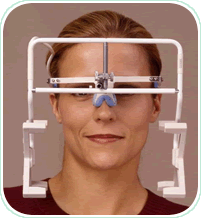
 Electromyography
Electromyography to monitor muscle activity at rest and during function.
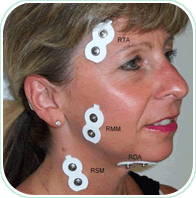
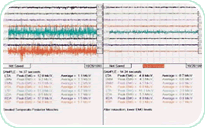 Transcutaneous Electrical Neural Stimulation (TENS)
Transcutaneous Electrical Neural Stimulation (TENS) ultra low frequency stimulation to relax spastic hypertonic masticatory muscles.
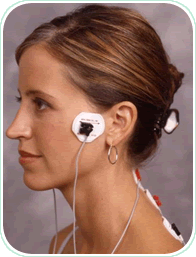
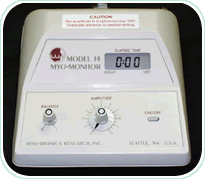

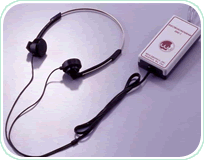 Sonography
Sonography to record aberrant TMJ sounds to assist in diagnosis.
In addition to the computerized-diagnostics, a comprehensive TMD examination also includes a
complete dental/medical history, necessary radiographs, extraoral and intraoral muscle palpation,
diagnostic molds of the teeth and photographs.

The goal in treatment of TMD/MSD is to determine a position for the mandible where
the masticatory muscles can be in a neutral unstrained state when at rest but can
reach maximum function when called upon. This is the " physiologic rest position".
It also places the TMJ's in a comfortable unstrained position. The mouth must be
able to close where the muscles are most comfortable. After determining the physiologic
rest position with the computer diagnostics, the bite is recorded at that precise point
for fabrication of an orthotic. The orthotic is an interdental device which serves as a
new biting/chewing surface where the patient can readily find their new neuromuscular
position. The orthotic alleviates myofacial pain and allows the TMJ's to be stable.
The orthotic is generally worn for 4-6 months after which the occlusion can be finalized
by the use of bite restorers (semi-permanent orthotics), orthodontics, fixed reconstruction
(crown and bridge procedures), partial or complete dentures or any combination of these
treatments. TMD/MSD treatment frequently requires referrals to physical therapist, chiropractors
or massage therapists. Resolution of the muscular imbalances and postural concerns are an
integral part of TMD/MSD treatment. If you feel you suffer from TMD or bite related problems,
please contact us for a complimentary consultation.